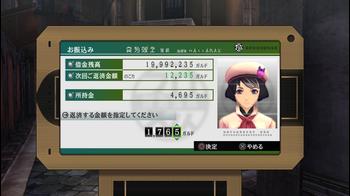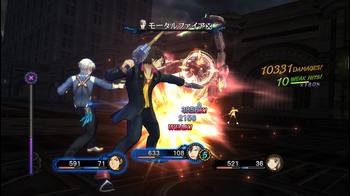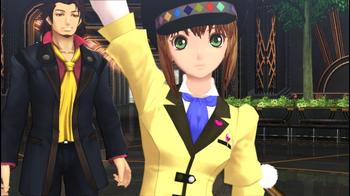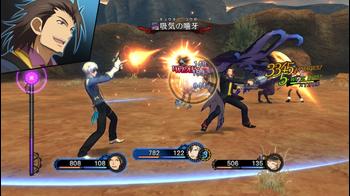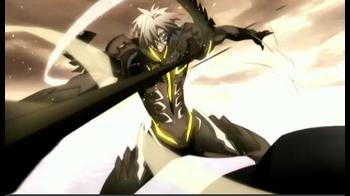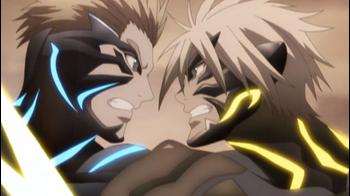
Tales of Xillia 2 Import Review
Bipolar and sometimes unfriendly, Tales of Xillia 2 is an odd beast of sorts especially considering the franchise history and pedigree. Numerous changes that break the structure that has been used time and time again by the series’ outstanding history make the game something different. At the same time these changes are grounded with various narrative elements that propel the series in an interesting direction; couple this with the recent release of its predecessor and you have an equation for sure disaster. Luckily, Tales of Xillia 2 proves itself to be a herald of good news rather than doom.
Ludger Will Kresnik is the game’s cool protagonist but there’s an aura of difference about him compared to the series’ previous heroes. Rather than opting for a person with voice, Ludger is a silent hero and remains that way from beginning to end. This translates into a form of projection where the player is supposed to be Ludger. There will be portions of the game where choice becomes a huge factor to emphasize Ludger as an image of the player. Always being two choices available, Ludger must choose and often times these choices will have consequences that result in a certain scene playing out differently or characters bonding closer to him. This means making choices are worthwhile and rather than being arbitrary, they are meaningful.
The silent characteristic is something unique to Ludger and while the idea of the player feeling like he is Ludger comes across well, the execution isn’t there. First off, many of the cutscenes that involve Ludger feel very empty and devoid of personality due to his silence and lack of emotional portrayal. It’s clear that something is supposed to be in the cutscenes or the character interactions to make them feel fluid. Often times it’s your party conversing amongst each other, and while Ludger does get involved in these conversations he doesn’t add much with the exception of the binary choices that you make. These one-sided like interactions can get annoying very quickly. Secondly, many of the cutscenes are portrayed in ways where Ludger is supposed to have a very distinct reaction but it doesn’t occur. Ludger isn’t a clean slate; he’s someone who has a specific personality but because it isn’t effectively portrayed, it makes him a robot of sorts.
Despite this problem, Ludger is an interesting character and this is mostly due to his interaction with Elle. This enthusiastic eight year old girl is the crux of Xillia 2 in more ways than one. She serves as the voice of Ludger at times often bringing an air of childish innocence that the party lacks. However, most importantly, Elle shares a close bond with Ludger. Almost like a father and daughter, the trials that these two face test their relationship and to see them grow closer over time is extremely sweet.
In fact, Tales of Xillia 2’s narrative is surprisingly great; the payoff for the characters that you interact with and the grand plot it holds is something of a spectacle. The story’s premise has Ludger destroy Time Factor’s that exist in the Parallel World in order to maintain balance in the Real World. Unfortunately, these missions are not as they seem as Ludger is forced to discover the real meaning behind the Parallel World and why he is the only one able to accomplish these tasks. It’s a simple premise that doesn’t try to sell the game’s narrative as anything special but is so much more. Xillia 2 is also much more violent than its predecessors and as a result deals with heavy themes such as murdering familiar faces. It’s this change that sets Xillia 2 apart and makes it a better game.
The game is split up into chapters and completing just the main quest will take around twenty hours. These chapters are broken up using the debt system. Early on in the game, Ludger is placed into debt and must pay it off over the course of the game. In order to progress from one chapter to the next, players must pay off a certain amount. While it’s a nice way to segment the various portions of the game, it’s an extremely limiting and poorly executed system. Nova, your debt collector, will call when a certain amount of money is in your wallet and will demand payment. If you refuse, she’ll keep calling until you give her the amount. In addition, these debts hold players back from progressing to the next chapter since they have to farm the money to progress, but this happens towards the end of the game. The combination of these two traits make the debt system infuriating and an aspect of the game that almost seems pointless in the grand scheme of things. It exists for the sake of padding the game’s length.
Even better than the main quest are character episodes. Between each main chapter are character chapters that players can partake in. By talking with characters that idly stand in towns, you can start them. These quests are an absolute joy due to seeing the psyche of these characters and the growth that they undergo. For instance, Alvin still has issues of trust and moral ambiguity that he struggles with from the original game. This breakdown of right and wrong is portrayed well and it’s fun to see how Alvin developes over the course of the game. On the other hand, Jude being a researcher of Spirits struggles with how humans and Spirits can live in harmony. As Ludger becomes more involved with Jude’s fight, you can see a more mature side to him - something that didn’t exist in the first game. While Xillia 2’s character chapters are great on their own, they are much more rewarding if the first game is experienced prior as the payoff for seeing how they are doing after the one year gap is immensely high.
All of these narrative elements come packaged in great visuals. Xillia 2 still utilizes the visual style of the first game and its technical strength hasn’t improved much, but the artistic style of the game is wondrous. The technologically advanced towns and desolate lands in Elenpios are portrayed well and the washed out colors work well for the Parallel Worlds. It definitely captures the feeling of hopelessness but a chance of something better that is themed throughout the entirety of the game. These graphical strengths truly shine in some of the amazing cutscenes that are in the game. The action choreography is solid and the camerawork truly captures the anime-style fights. It may seem a tad generic but once you see it, your mind might change.
Visual excellence is carried over into the game’s feature presentation: the combat system. Xillia 2’s combat system plays the same way as the original - using the Double Raid Linear Motion Battle System. Moving on a 2-D axis, you control one character from a group of four in combat and dish out damage using normal attacks and special moves. At first this might seem simple but there are systems in place to make the fighting more meaningful. Linking is back from the previous game and by connecting with other characters in the party, players will attack foes in unison and pull off extremely powerful Link Artes. The bar on the far left is the Overlimit Gauge and is sectioned off into multiple parts. Once it fills up to a certain point players can execute a Link Arte after performing Artes. However, unlike it’s predecessor, Xillia 2 adds Common and Unique Link Artes. While Common can be pulled off by using any particular Arte, the Unique requires you to use a particular Arte that will trigger a special move exclusive to you and your linked partner. It’s a nice addition and makes for creating a series of awesome Link Artes that much more rewarding.
In addition, combat has been streamlined due to on the fly tactics control. By linking up with a character you are able to change their battle style using the D-pad. Long gone are the days where you can tell an ally to back off from attacking a certain enemy from the menu. This simple addition truly changes the flow of battle and continues fights at a brisk pace. Not only this, but linking with characters will yield great benefits as their unique passive effects - or active ones - will further enhance your battle potential.
New to the sequel, is a weakness system and exploiting an enemy’s weakness will make encounters easier to deal with. On the flip side, enemies also have resistance against certain types of attacks or elements and this will make your fight harder than normal. However, by taking it one step further, exploiting weaknesses multiple times or multiple weaknesses at once will increase your damage multiplier and prevent enemies from retaliating. This addition is welcome and rewards players for utilizing the various Artes they have at their disposal to crush their foes while avoiding ones that might endanger them.
The bosses in particular will test your mettle as they typically don't have many weaknesses. Certain Skills that you equip on individual characters can break the guards of your foes, leaving them completely open to dish out an exorbitant amount of damage. To earn these Skills, players must make use of the Aerosoul Orbs - the game’s progression system. While players will level up and earn stat points accordingly, the Aerosoul Orb serves to further specialize them with unique abilities that will aid them in battle. In order to attain Skills, players access the Aerosoul Orb menu and select an elemental booster. There are six elemental routes for a character and each provide a set of Skills and new Artes for said character to unlock. By equipping the various Aerosoul Orb plates, players can progress along each elemental route. Certain plates will allow characters to progress through more than one elemental route, even at a faster rate. By equipping the various plates that you attain throughout the game, players have a great control over how they want to build their character as each elemental route helps to build a character in a certain direction. It’s a simple customization system at first, but almost works like a puzzle as you must find out what elemental routes are more useful than others.
Speaking of characters, Xillia 2 adds in three new characters to spice things up. Ludger, Gaius, and Musee bolster the already packed party and these characters add even more diversity in the field of battle - whether you’re soloing creatures or handling them as a group. Ludger, especially, plays exceptionally well due to his tri-wielding weapon system. Able to utilize dual blades, dual pistols, and a hammer - an odd weapon to round out the trifecta I know - Ludger has an extremely varied assortment of Artes. The best part of Ludger is that he is able to interchange between the various weapons on the fly, making for some extremely fun combos that rival even Devil May Cry. It's intuitive and the battle system is all the better for it. In fact, if there’s a downside for Ludger being so amazing is that he feels almost overpowered.
Ludger’s strongest ability is Corpse Shell, which strips away all normal combat conventions in the game forcing Ludger to goes against his enemies solo. However, not all is bad as Ludger is unkillable in this mode and he can infinitely string attacks together to finish off his foes. While Ludger is in Corpse Shell he gains a new array of attacks and is able to maximize damage that might not have been possible when he’s not. At the bottom right of the screen is a timer and once Ludger’s time runs out, or once he receives a certain amount of damage, he’ll transform back to normal and the game will resume. Corpse Shells is an extremely odd combat system mostly because it removes everything that defines the DRLMBS and throws in new mechanics that feel devoid of meaning. At most, Corpse Shell feels like a safety net in which players can activate to avoid characters dying or go into a brief moment of invincibility to deal out extra free damage. While Ludger pulls off cool moves, Corpse Shell at best feels like all flash and nothing substantial.
The remaining two new characters Gaius and Musee add more melee and magic prowess with their own individual quirks. Gaius especially focuses on overwhelming the enemy through sheer brute force with many of his powerful Artes taking up a large amount of TP - the game’s version of mana. Musee on the other hand acts as an exceptional mobile mage assisting allies from zipping in close to enemies. None of these characters feel tacked on and simply add more diversity and joy to an already great combat system that’s been laid out by the first Xillia. The characters from the previous game have received tweaks making them more balanced and enjoyable to play as well, including the addition of new Artes.
The combat system as a whole is extremely deep in Xillia 2 - adding new features and replacing old ones that make it feel old but at the same time refreshing. However, the combat system is not without faults. At certain points of the game players won’t have access to the entire cast and will be left with a fixed party. This is particularly annoying in certain chapters as bosses will pose an absurd amount of aggravation especially if you don’t have a healer. The choice to also remove realtime party member switching in combat is also disappointing as it was an excellent addition to Xillia allowing players to switch out for characters that are more useful in combat.
Xillia 2’s faults don’t end there. The game is a direct sequel to Tales of Xillia and as a result nearly everything in the game is a carbon copy of it. The environments are unchanged, the monster designs are all the same, and the boring, old wastelands are still the boring, old wastelands. The reusing of assets is abused heavily in Xillia 2 and it’s extremely saddening that such a game would be marred by it.
The audio of the game is on par with the previous title if not better. The various orchestral and rock themes add diversity to the tunes that play both in the fields you explore or the battles that you engage in. It’s easily the best array of tracks the series has seen yet and while they’re not all memorable, some of them might tug at your heart. The voice acting is equally endearing as Elle stands out as a particular marvel. The delivery and intonation that is portrayed in Elle is phenomenal, making each cutscene and interaction involving Elle an enjoyable moment. Ludger on the other hand is silent but the game has a feature to add his voice on a second playthrough. Everyone from the previous game has their reprising voice actors and they all do a standout job as well.
Tales of Xillia 2 is hard to judge. Were it a stand-alone title rather than a sequel, filled with unique assets and resources, it would stand as one of the shining JRPG gems of this generation. Unfortunately, the amount of reused content and repetitiveness that is carried over from Tales of Xillia brings its greatness down. It’s hard to judge one’s enjoyment of Xillia 2 as it will be directly correlative to how patient one is with the similarity between the two games. However, if you can overlook the game’s unavoidable faults of being a sequel and enjoy the game as just another JRPG, Tales of Xillia 2 is a game you would do well not to miss.
Disclaimer: This game is only released in Japan meaning Japanese efficiency is highly recommended. It is possible to play with translations and little Japanese but you might not receive the full experience possible.

